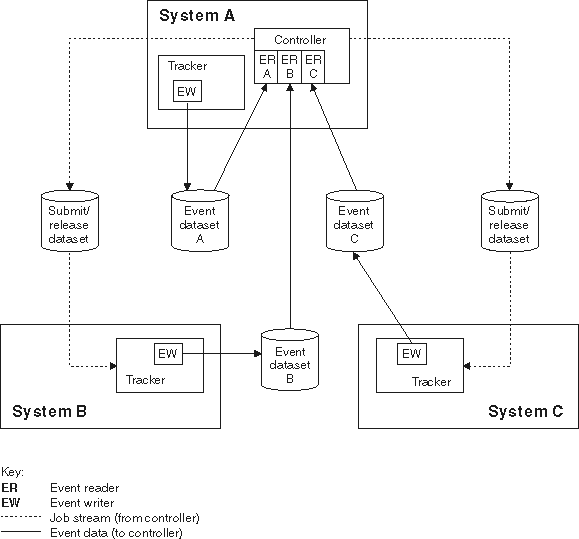Individual systems connected via shared DASD
Individual systems connected through shared DASD shows three z/OS systems connected via shared DASD.
System A is the HCL Workload Automation for Z controlling system. Systems B and C are controlled systems, each of which shares a submit/release data set with the controlling system. Each of the three systems is represented by a computer workstation. The destination field in the workstation description for System A is left blank, indicating that HCL Workload Automation for Z should submit work to the system that the controller is started on. The destination field in the workstation descriptions for Systems B and C contains the DD name of the submit/release data set connecting them to the controller. Work is sent to the correct submit/release data set and is then passed to the corresponding system for processing by the event writer on that system.

The event writer subtask on each system writes event information to its event data set. Three event-reader subtasks, one for each of the event data sets, are started in the controller on System A. The controller reads the event data sets and updates the current plan.
Automatic workload restart can be invoked in this configuration if an I/O error occurs when the controller attempts to open a submit/release data set. The workstation that has this submit/release data set as a destination is given the offline status, and WLR actions are taken according to the options specified on the WSOFFLINE keyword of the JTOPTS initialization statement.
Example EQQPARM members for the previous figure shows the initialization statements you can use to create the configuration in Individual systems connected through shared DASD.
|
EQQPARM members for System A |
|
|---|---|
|
CONTROLR
|
TRACKERA
|
|
ERDRA
|
TRKAEW
|
|
ERDRB
|
|
|
ERDRC
|
|
|
EQQPARM members for System B |
|
|
TRACKERB
|
TRKBEW
|
|
EQQPARM members for System C |
|
|
TRACKERC
|
TRKCEW
|